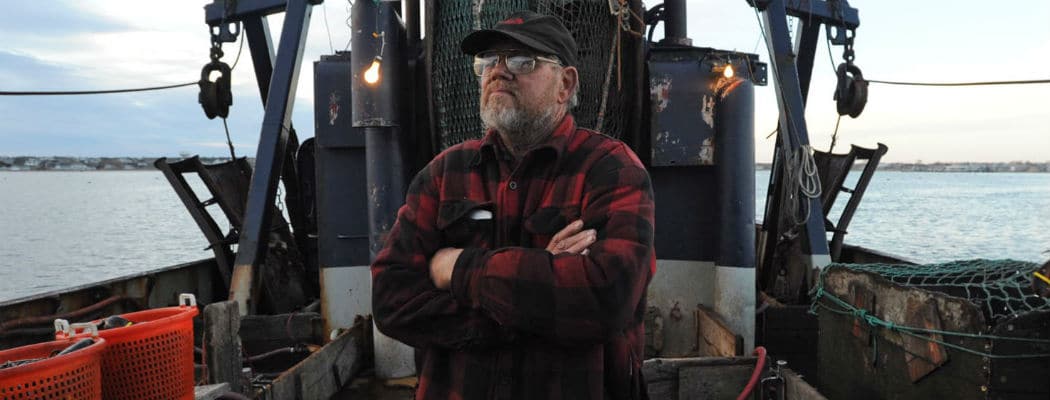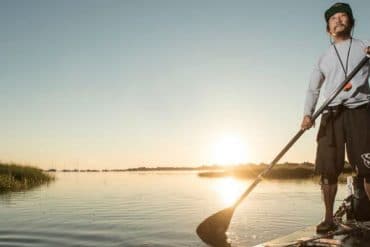How the Nantucket Community kept its last commercial fisherman staying afloat.
 The ten thousand-pound basking shark came out of the water headfirst into Bill Blount’s net, thrashing in the stern ramp of his commercial dragger, the Ruthie B. Though they are the second largest fish in the world, basking sharks eat plankton, so they pose no threat to humans — at least when they’re still in the water. But this one, the size of a small bus, was now on Blount’s boat and big enough to injure him or worse as he worked to free it from his net.
The ten thousand-pound basking shark came out of the water headfirst into Bill Blount’s net, thrashing in the stern ramp of his commercial dragger, the Ruthie B. Though they are the second largest fish in the world, basking sharks eat plankton, so they pose no threat to humans — at least when they’re still in the water. But this one, the size of a small bus, was now on Blount’s boat and big enough to injure him or worse as he worked to free it from his net.
Blount, the captain of the last offshore commercial dragger out of Nantucket, was about sixty miles east of the island in the legendary fishing grounds of Georges Bank. As he attempted to cut the massive shark out of his net, Blount started to slip underneath it and got pinned. “I didn’t want to go under it,” he remembered. “The thing weighed 10,000 pounds!” Blount’s crew managed to grab him, and slowly pulled him out of the ramp and away from danger. Minutes later, they successfully freed the enormous fish, too.
Two years after his run-in with the basking shark, Blount sat in the safety of the living room of his mid-island home on Vesper Lane on a chilly morning in March, recalling for me one of the countless stories from his decades spent plying the offshore waters of New England.
 Over the course of our conversation, Blount twice reminds me that his trade is “the most dangerous job in North America.” About once a year out on the water, he says, “there’s been a case when I should have lost my life.”
Over the course of our conversation, Blount twice reminds me that his trade is “the most dangerous job in North America.” About once a year out on the water, he says, “there’s been a case when I should have lost my life.”
Yet these days, it isn’t the inherent dangers of offshore fishing that have him worried. Blount is essentially trying to survive as a mom- and-pop venture in a consoli- dating industry that is in the throes of a painful collapse. “We’re a broken industry now,” he says. “And we just don’t have any money.”
Blount gives a Cliffs-Notes version of the misfortunes that have befallen the commercial fishing business of the Northeast: the declining fish stocks, the ever-tightening regulations and restrictions, as well as the rising costs of keeping his 36-year-old boat up and running. But this old salt has learned some new tricks along the way. With a little help from some friends, Blount is now using the Internet to capitalize on the crowd funding and direct-to-consumer trends that have launched projects, preserved challenged businesses, and upended entire industries. And it just might keep him afloat.
At 69, Willis “Bill” Blount cuts an unassuming figure, at least when he’s on land. Blue-eyed, bearded and bespectacled, he speaks thoughtfully with a soft and measured voice about the challenges of captaining the last dragger out of Nantucket. Even as the island’s commercial fishing bona fides have faded in recent decades, Blount remains a living connection to Nantucket’s long legacy of launching fishermen out into the Atlantic and beyond.
Last spring, however, his ride almost came to an end. Blount’s insurance company said that he couldn’t leave the dock until the Ruthie B had been hauled out, had its hull cleaned and repainted, and had an audio gauge to determine the thickness of its steel. Blount simply didn’t have the money to make the repairs or cover a down payment. And yet he needed to fish to get money. It was a catch-22 that Blount couldn’t see his way out of. “There was consideration of this being the end, and I can’t probably go anymore,” Blount said. “I had to consider that.”
 Word of his predicament leaked out in the community, and Blount was soon connected with the island non-profit Sustainable Nantucket, an organization that saw value and something meaningful in keeping the Ruthie B operating. A plan was hatched to utilize Kickstarter — the crowd funding company that allows users to make online donations to projects seeking funding — to get Blount back on the water. “I had no clue what Kickstarter was,” Blount said. “I figured, let’s give it a try. I didn’t know what I was doing, but I said ‘sure, let’s try it.’” The Kickstarter campaign featured videos of Blount and his wife describing their dilemma, along with island restaurateurs and others singing the praises of Blount, the Ruthie B and the fish he brings back to the island. A goal of $27,000 was set.
Word of his predicament leaked out in the community, and Blount was soon connected with the island non-profit Sustainable Nantucket, an organization that saw value and something meaningful in keeping the Ruthie B operating. A plan was hatched to utilize Kickstarter — the crowd funding company that allows users to make online donations to projects seeking funding — to get Blount back on the water. “I had no clue what Kickstarter was,” Blount said. “I figured, let’s give it a try. I didn’t know what I was doing, but I said ‘sure, let’s try it.’” The Kickstarter campaign featured videos of Blount and his wife describing their dilemma, along with island restaurateurs and others singing the praises of Blount, the Ruthie B and the fish he brings back to the island. A goal of $27,000 was set.
As the campaign got underway, the question lingered: would the communi- ty answer the call and really come to the rescue of a for-profit fisherman? “I had no idea,” Blount said. “I was amazed on the first day when some money started coming in.”
It started as a trickle. With the help of social media, it became a torrent. By the end, 143 people had committed $34,170, far exceeding Blount’s goal with time to spare. With the money in hand to haul the boat, pay for fuel, and make all the necessary repairs and inspections, Blount was able to return to the water last summer.
For Blount’s wife, Ruth, for whom the Ruthie B is named, the experience elicited a range of emotions. “It was a very humbling experience, and also very heartwarming, and it was also extremely stressful,” she said. “Just wanting to do it with integrity, hating to ask, and we didn’t really get Kickstarter yet…For us, it was the only way to get over this hurdle.”
Featured throughout the Kickstarter campaign was the Ruthie B itself. Blount, who holds a degree in mechanical engineering from the University of Maine, designed and built the Ruthie B in his father’s shipyard in Warren, Rhode Island over the span of a little more than a year in the late 1970s. On most days, Blount was the foreman of the construction crew as the seventy-seven-foot steel-hulled boat came together.
 The Kickstarter campaign also provided Blount with a way to showcase another new innovation he had adopted from others: a Community Supported Fishery program, or CSF, modeled after the community-supported agriculture movement that is helping many small farms. Instead of selling his catch solely to fishmongers and restaurants, the CSF allows Blount to sell shares of fish to individual consumers before each of his offshore trips, so they absorb both the risks and rewards of his business. Each share costs $50, and is worth about ten pounds or more of whole fish.
The Kickstarter campaign also provided Blount with a way to showcase another new innovation he had adopted from others: a Community Supported Fishery program, or CSF, modeled after the community-supported agriculture movement that is helping many small farms. Instead of selling his catch solely to fishmongers and restaurants, the CSF allows Blount to sell shares of fish to individual consumers before each of his offshore trips, so they absorb both the risks and rewards of his business. Each share costs $50, and is worth about ten pounds or more of whole fish.
“When I leave the dock I give them an e-mail or call them and tell them I’m going fishing, if they want to cash a share in they can,” he said. “If you’re reason- ably able to filet fish, it’s probably the best deal, money-wise, you’re going to get. And you also get to try all different species.” Blount recently expanded the CSF to New Bedford, where the Ruthie B is currently docked due to the extensive damage done to the Nantucket town pier during this past winter’s storms.
Back on Vesper Lane, Blount swipes a gnarled finger across the screen of his iPhone, quickly scanning through the results of a Google image search for “basking sharks” to show me the true size of the fish he encountered in Georges Bank. Whether it’s Kickstarter, Facebook, or an Apple smartphone, Blount is clearly unfazed by the technology. He becomes most animated, however, when I asked him why, despite all the hardships and difficulties of plying one of the most regulated fisheries in the world, does he continue to fish even as he approaches seventy? “Fishing,” he says, “is fascinating.”
The troubles he described earlier fade away, and Blount speaks of his trade with a certain joy and romanticism that might make a person question their own chosen profession. “When you leave the dock and you start going and all of a sudden it’s like going into another world, like going into Narnia,” he says. “You go through a curtain and you come into a whole new world, a totally different world that a person on the shore would never be aware of. There’s beauty like you can’t believe.”






